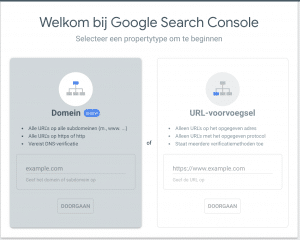Google Search Console, the ideal performance tool for SEO
How exactly is your website performing? Getting insights into your website’s SEO performance is desirable these days. To then optimize your website for targeted SEO.
Creating a property in Google Search Console. So how do you get the desired SEO data to map out the relevant optimizations? For this, you can use many different paid/unpaid tools. For example, you can use paid tools such as Ahrefs, SemRush and RankRanger. But there are also several unpaid tools available ScreamingFrog, Ubersuggest and FatJoe.
Google has not been idle in recent years, either. To provide webmasters with feedback on how the health of the website is doing, they developed an online performance tool. The name Google Search Console is probably familiar to most webmasters. In early 2018, Google launched the new version of GSC which again brought many new features.
What is Google Search Console?
Google Search Console is an online performance tool which as just mentioned provides insight into the performance and health of the website. It provides insight into how your website is seen by Google and, for example, what errors are found within your website. Google Search Console offers the following insights, among others:
- SEO performance (click, impressions, CTR and Position) in Organic search results and Discover
- Understanding the crawl budget
- Robots.txt test
- Fetch and render (how google sees your web page)
- XML sitemap submission/verification
- Structured data validator
- Amp validator
- SEO Penalty checker
- Internal/External links indication
- Understanding how many pages Google found within the domain
- Mobile usability
- URL inspection
How to set up Google Search Console:
- Go to Google Search Console and log in with your Google account.
- Create a property (Domain or URL join);

Advice if you understand how to create a DNS record to create a domain property. The benefits you get is a complete view of all web pages within the domain incl. http/https and subdomain. Should you choose the simple variant, there are several ways to create the property. For example, the easiest ways if you already have Google Analytics or Tag Manager set up are to use one of the tools to verify your ownership. If this is not possible, you can easily verify your ownership via an html file or script. Be careful not to delete the HTML file or script after verification!
- Done, start discovering the tool.
Now that verification is complete, you can start commissioning the tool. Below are some tips for using Google Search Console effectively.
- Your website’s SEO performance. This allows you to see which pages/keywords/images are performing well or perhaps not so well. You get insight into clicks/impressions/Click Trough Rate and Average Position. Should you run an international website, you can also gain insight into how the website is performing internationally.
- URL inspect, this gives you page-level insight into how the web page is seen by Google.
URL Status: you can view the crawled page, if the page is not yet indexed then you can request for indexation.
Crawl: Here you get to see how Google found the web page, for example internal links or XML Sitemap and when the web page was last crawled.
Indexation: Provides insight into whether the web page may be indexed and whether the web page has a referring or self-referring canonical and whether Google accepts the canonical by Google. - Coverage/Coverage: provides insight into the health of the website. How many pages contain errors, are available and excluded. You also gain insight into which errors are found by Google.
- Sitemaps: Here you can have the XML sitemap imported. Once Google has checked the XML Sitemap, you also get insight into whether the web page contains only valid pages. Should there be pages with a redirect, referring canonical or when urls are excluded by the robots.txt they will be displayed as errors.
- Mobile Usability: After a failed attempt by Google with the rollout of “mobilegeddon,” April 21, 2015, Google rolled out March 26, 2018 a ranking factor “Mobile First Indexing.” Therefore, it is important to provide your website with a responsive design so that you offer Google the ideal mobile experience. Should Google experience errors, they will be pointed out here.
- Manual actions: When Google observes activities on your website that are against Google’s guidelines, a notification in the manual actions tab notifies the webmaster of the observation. Urgent advice to take the report seriously and resolve the issue. Reporting can do serious damage to website performance. If you can’t figure it out feel free to contact us.
- Security: When your website contains a download file with errors or malware infection, the issue is indicated in the security tab. The issue indicates the harmful page and what needs to be fixed.
- Links: here are all the internal/external links found by Google. This will give you a rough idea of how your external authority ranks and whether all pages have inbound links. Should this not be the case, you can include as an optimization that missing pages should be provided with inbound links.
In short, Google Search Console is the right tool for every webmaster to monitor your SEO performance. If there are any points you can’t resolve please let us know so we can help you.



